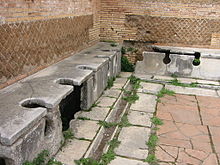This is an old revision of this page, as edited by MarkBernstein (talk | contribs) at 15:24, 28 January 2007 (Which baths?). The present address (URL) is a permanent link to this revision, which may differ significantly from the current revision.
Revision as of 15:24, 28 January 2007 by MarkBernstein (talk | contribs) (Which baths?)(diff) ← Previous revision | Latest revision (diff) | Newer revision → (diff)
- Ostia redirects here. For the modern districts of Rome of this name or similar, see Ostia (modern district) and Ostia Antica (district), and for the modern town see Ostia (town).
Ostia Antica was the harbor of ancient Rome and perhaps its first colonia.
History
Origins
Located at the mouth of the River Tiber, Ostia was said to have been founded by Ancus Marcius, the fourth king of Rome, in the 7th century BC. A later inscription refers to the event . However the most ancient archaeological remains so far discovered are no older than the 4th century BC. The most ancient buildings currently visible are from the 3rd century BC, notably the Castrum (military camp) and of a slightly later date are, the Capitolium (temple of Jupiter, Juno and Minerva). The opus quadratum, the walls of the original castrum at Ostia provide important evidence for the building techniques that were employed in Roman urbanisation during the period of the Middle Republic.
Although Ostia was probably founded for the sole purpose of military defense — since hostile armies could eventually reach Rome by water through the mouth of the Tiber River — in time the port became a very important commercial harbor.
Many of the goods that Rome received from its colonies and provinces passed through Ostia, including the essential grain supply to the city of Rome. In this role, Ostia soon replaced Pozzuoli, known to the ancient Romans as Puteoli, a port near Naples).
In 87 BC, the town was razed by Marius, and again in 67 BC it was sacked by pirates. After this second attack, the town was re-built and provided with protective walls by the statesman and orator Marcus Tullius Cicero. The town was then further developed during the 1st century AD, mainly under the influence of Tiberius, who ordered the building of the first Forum. The town was also soon enriched by the construction of a new harbor on the northern mouths of the Tiber (which reaches the sea with a larger mouth in Ostia, Fiumara Grande, and a narrower one near to the current Fiumicino International Airport). The new harbor, not surprisingly called Portus, from the Latin for "harbor," was excavated from the ground at the orders of the emperor Claudius. This harbor was later supplement by a harbor built by Trajan finished in the year AD 113 ; it has a hexagonal form, in order to reduce the erosive forces of the waves.

The town was provided with all the services a town of the time could require; in particular, a famous lighthouse. Archaeologists also discovered the public latrinas, organized for collective use as a series of seats that allow us to imagine today that the function was also a social moment. In addition, Ostia had a large theatre, many public baths, numerous taverns and inns, and a firefighting service.
Trajan too, required a widening of the naval areas, and ordered the building of another harbor, again pointing towards the north. It must be remembered that at a relatively short distance, there was also the harbor of Civitavecchia (Centum Cellae), and Rome was starting to have a significant number of harbors, the most important remained Portus.

Rise and fall of Ostia
Ostia grew to 50,000 inhabitants in the 2nd century and in time focused its naval activities on Portus. With the end of the Roman Empire, Ostia fell slowly into decay, and was finally abandoned in the 9th century due to the fall of the Roman Empire in combination with repeated invasions and sackings by Arab pirates; the inhabitants moved to Gregoriopolis. In the Middle Ages, bricks from buildings in Ostia were used for several other occasions. The Leaning Tower of Pisa was entirely built of material originally belonging to Ostia.
A "local sacking" was carried out by baroque architects, who used the remains as a sort of marble store for the palazzi they were building in Rome. Soon after, foreign explorers came in search of ancient statues and objects. The Papacy started organizing its own investigations with Pope Pius VII and the research still continues today. It has been estimated that two thirds of the ancient town have currently been found.
For the naval battle of 849 between Christian and Saracens, see Battle of Ostia.
Photos
-
 The inscription originally placed on the main gate.
The inscription originally placed on the main gate.
- The theatre as seen from the ancient main road. The theatre as seen from the ancient main road.
- Inside the theatre. Inside the theatre.
- Mosaic floor in the market. Mosaic floor in the market.
External links
- Ancient Ostia Virtual panoramas and photo gallery (English/Italian)
- Ostia — Harbor City of Ancient Rome including an introduction (English)
- Ostia Antica (Italian/English)
- Extensive photo gallery of Ostia (English)
41°45′N 12°18′E / 41.750°N 12.300°E / 41.750; 12.300
Categories: